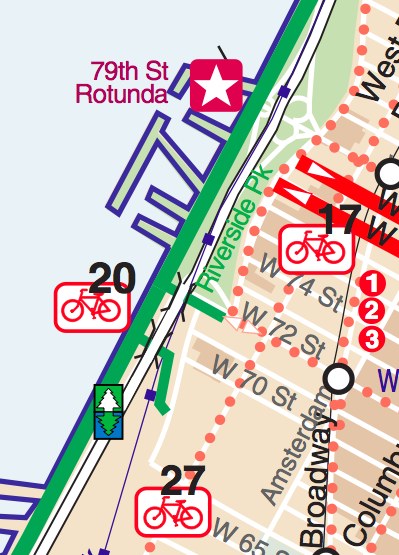
The Hudson River Greenway is the busiest bike route in the city, with around 5,000 cyclists riding it during the peak 12-hour period each day. This June, the Parks Department abruptly put up dismount signs at the 72nd Street entrance to Riverside Park, interrupting a popular access route to a major corridor within Manhattan's green transportation network.
Cyclists, pedestrians, and dog walkers all use the 72nd Street entrance heavily, and while no resolution has yet been reached, many now see adding bike lanes at other greenway access points as the best way to reduce conflict. But even if those plans are pursued, cyclists won't be able to ride this critical link without fear of getting fined unless the Parks Department changes the dismount policy.
At a meeting of the Manhattan Community Board 7 Parks Committee last night, CB members, the city, and local activists seemed to coalesce around a plan to improve bike access to the greenway at 79th Street, taking some pressure off 72nd and thereby mitigating the rationale for dismount signs. Both committee co-chairs saw the 79th Street plan as a partial solution worth pursuing and steered the conversation toward the more controversial question of what to do on the 72nd Street path.
Parks Department Greenway Coordinator John Mattera explained the 79th Street idea using an electricity analogy. "Bicycles follow the path of least resistance," he said. If you want to reduce conflict on the 72nd Street path, he added, "the way to do that is to make a lightning rod out of 79th Street." With fewer cyclists at 72nd, he said, the dismount policy could be swapped for something a little less heavy-handed. Mattera said that he'd spoken with the NYC DOT and that "as sure as anything can be at City DOT," striping a new bike lane along 79th and leading into the park was part of their plan for 2011.
The plan got a generally positive response as a way of reducing conflicts between park users, though not everyone agreed with Mattera's proposal. "Another way you guide electricity is by adding resistance, and there should be resistance at 72nd Street," said committee member Tom Vitullo-Martin.
Though the lightning rod idea was popular in theory, implementing a safe access route from 79th Street could prove difficult in practice. "It's a great idea, but it's going to take a whole lot more than paint to make it safe for cyclists," said Upper East Side resident Steve Vaccaro, who noted that cyclists would be riding by a highway off-ramp.
While everyone agreed that siphoning off some bike traffic from 72nd Street would help, waiting until those changes are in place would leave the dismount policy intact at least until next year.
Momentum on the community board seemed to be in the direction of walking back or replacing the dismount policy. "A 24/7 dismount is way overkill for the degree of congestion at that path," said committee co-chair Klari Neuwelt, suggesting that it could be in effect only at the hours of peak use. "It has led to a lot of potentially unnecessary antagonism between user groups."

Similarly, co-chair Elizabeth Starkey wanted to see a solution that enabled all park users to coexist, rather than putting the entire burden on cyclists. Ideas proposed over the course of the evening ranged from more creative signage urging slow speeds, to placing volunteer cyclists at the path to send the slow-down message, to building some sort of speed bump that only affects fast-moving bikes.
In the background of the whole discussion was the question of whether bikes are even allowed on the 72nd Street path in the first place. Riverside Park Administrator John Herrold claimed they are not. "Cycling is in fact illegal on any park path," he explained, adding that until recently, the department had chosen not to enforce that rule in Riverside Park.
However, as many in the audience pointed out, the 72nd Street path to the Greenway is clearly marked on the city's official bike map, which bears the Parks Department seal and Commissioner Adrian Benepe's name. The inclusion of the 72nd Street path on that map for many years, said Herrold, has been "a mistake."
Of course, it's not just the maps. Directly above the "cyclists dismount" signs, markers on the path indicate that it's part of the Hudson River Greenway.





